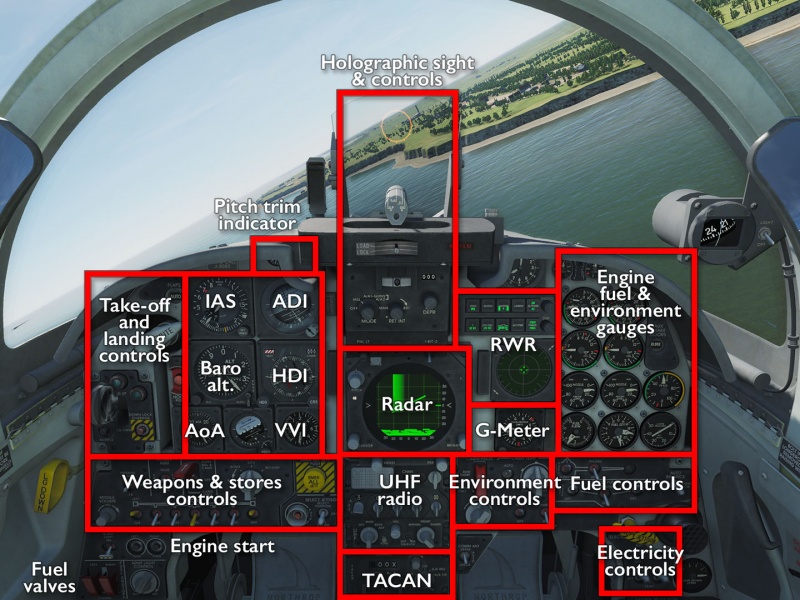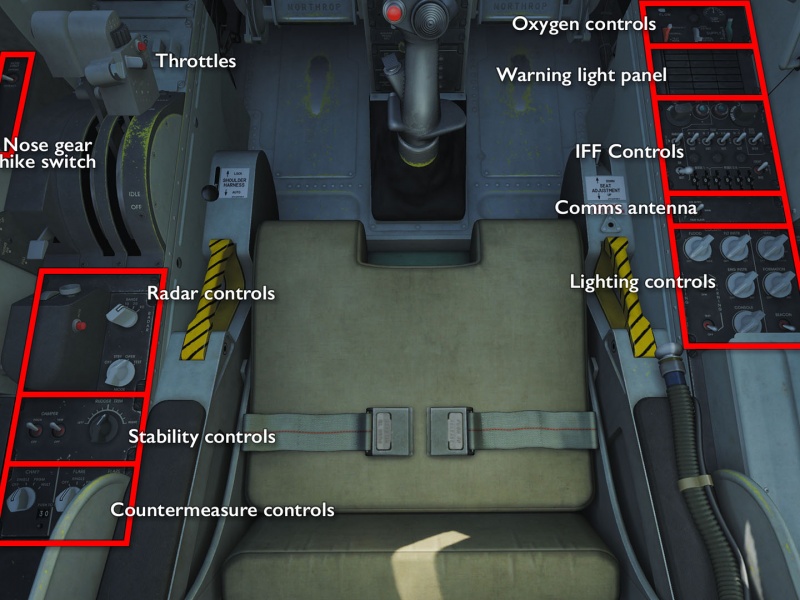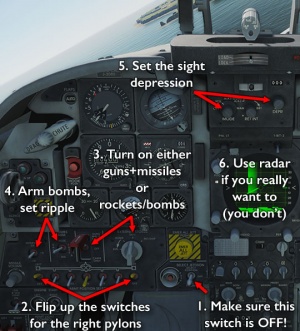F-5E-3 Tiger II
Ah, yes. the MiG-28, with its classified 4G negative dive. You definitely should try doing that — the wings will even stay on and everything (until you hit the ground).
More sensibly, the F-5 is based on the same basic airframe as the venerable T-38 Talon jet trainer, and remains in use to this day as a stand-in for lighter “red force” aircraft like the MiG-21 in dissimilar air combat training. Its numerous export (and later re-imported) versions have received layers upon layers of alterations and modernisations, with some variants being able to carry AMRAAMs, AGM-65s, and even laser targeting pods. Seeing where it ended up, it is not difficult to imagine the F-5 as a kind what-could-have-been alternative to the F-16: a small and light but very extensible airframe that you can bolt almost anything to. But all those extra features are for export and for much later periods — no such luxuries for pesky DCS pilots to enjoy.
Instead, the F-5E-3 featured here comes with very simple avionics and with a single pair of Sidewinders as its only air-to-air weapon (well… aside from a pretty competent pair of 20mm cannons that is). In fact, the F-5E-3 is almost completely devoid of “systems” to manipulate or to care about, and is therefore a superbly simple aircraft to fly and operate. It is small, while not incredibly fast, it can still go past Mach 1 and even carry a few stores with it while doing so. It is a light-weight, agile day-time multirole aircraft with a couple of simple pilot aids, but where most of the flying, navigating, and fighting has to be done by the pilot on their own.
Features
Aside from the obligatory MiG-28 skin, the F-5E-3 only comes with the bare minimum:
- A single UHF radio and a TACAN receiver as its only “advanced” navigational instrument.
- A somewhat temperamental RWR that likes to not show what is actually out there.
- Automated flaps and yaw/pitch stability enhancers, but no flight automation — only trim and a light hand to stay straight and level.
- A drag chute and an arrestor hook for (very) short landings. It is technically not carrier-capable, buuuuuut…
- An almost entirely pointless radar (ok, it helps with gunnery and lets you find targets BVR, but that is about all it is good for).
Flying the F-5E-3
The features list may look negative but that is because one key detail it is left out: the F-5E-3 is an absolute joy to fly. There is nothing to get between the pilot and the aircraft, and it does exactly what you tell it to, not what it thinks that maybe you meant to do. The pilot has to figure out where to go and how to get there, not just follow lines and cues on an automated map.
Cockpit overview
Getting into the air
One major upside of the simplicity of the F-5E-3 is that it can get into the air very quickly. There is no need to wait for alignment or data transfers &mash; just get the engines running and go. The downside is that it needs outside help to do this since it does not feature an APU.
- Turn on batteries, generators, and fuel pumps.
- Request ground air supply connection and application.
- Move left throttle out of detent and press its engine start button, then wait for the engine to spool up.
- Request a second ground air supply application (ground crew will move it to the right side on their own).
- Repeat for the right engine and then request that air be disconnected.
- Turn on stability switches and move the flaps thumb switch time the rear (auto) position.
- Hike up the nosewheel, set pitch them to ~6° up.
- Press and hold the stick nosewheel steering button and make your way to the runway.
- Push throttle to go-fast position, take off, and pull your wheels in.
Even some FC3 aircraft require more steps than this.
Shooting something
Smart weapons?!
Add-ons and files
- Tippis' Checklist (see also kneeboard mods).
- Chuck's F-5E-3 guide.
Related DCS modules
- Aggressors Basic Fighter Maneuvers (BFM) campaign.
- Aggressors Air Combat Maneuver (ACM) campaign.
More information
- Northrop F-5 on wikpedia.
- F-5E/F Tiger II on globalsecurity.org
- Bunyap's F-5 test flight video series.





